
Written by Eric Gans
I used to be a window contractor. More recently, I have tested thousands of windows as a certified energy auditor.
-2-6 min. estimated read time to get the information you need
Table of Contents
As a former window contractor turned certified home energy auditor I have been on both sides of the coin when it comes to replacement windows.
Early on I was convincing people (with the right intentions and wrong information) to replace windows to solve draft issues.
Now, I am on the other side getting called out for an energy audit to check windows because the new and old windows always seem drafty.
In fact, most people immediately connect comfort problems to windows and doors.
But, it usually turns out to be bigger problems that are lurking and they don't cost nearly as much to fix!
It took me years to figure it all out, but when you stop and think about it all for a moment - it really makes a lot of sense.
Here are five reasons that can help you answer the question:
Why do my windows feel drafty?
-Back to Top-
1. The Windows Are Not the Draft Source to Begin With
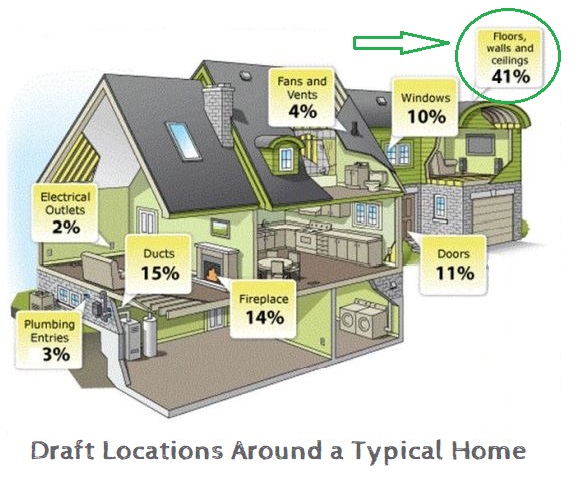
FACT: Windows Account for Only 10% of Total Air Leakage in a Typical Home
A misconception for most homeowners is that windows are the only location in your home's "shell" that air can get in and out.
But, there are many other places around your house that might be much more connected to the outside than windows.
And, a lot of these gateways are hiding in plain sight!
If your home is stubbornly drafty you need to think about the issue in three-dimensional ways. This does not mean that you wasted money on windows or that you need special glasses. It just means that you need to shift your hunt for the drafts by starting to look up and down instead of only through the sides.
FACT: Air needs some help to get through cracks and crevices around your home and the pressure inside your home is greatest at the top (attic) and at the bottom (basement/ crawlspace).
"If your home is stubbornly drafty you need to think about the issue in three-dimensional ways...shift your hunt for the drafts by starting to look up and down instead of through the sides."
Read on to learn about the stack effect and how getting the basics from this physics phenomenon can help you begin to think in three dimensional ways about drafts.
-Back to Top-
WATCH ON YOUTUBE
2. Understanding Stack Effect & How it Can Solve Your Draft Issue
In the book Rich Dad Poor Dad by Robert T. Kiyosaki, he talks about how as school children we are never really taught the vital lessons of personal finance and how to stay out of debt and save for the future. 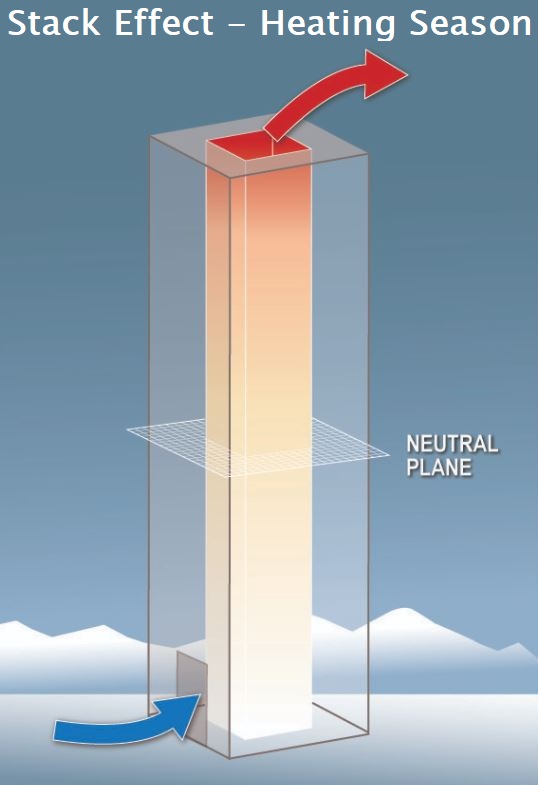
Similarly, I say everyone should learn about the stack effect when ready to purchase a home.
Understanding how it can play a big part in drafts around the house can really help you with better comfort and overall energy efficiency.
The stack effect can be simply understood by taking one concept we all learn as young children: Hot Air Rises
Here is the part they don't tell you when it comes to your home.
When the warm air rises in your house it creates a lot of pressure at the top and it escapes through all of the holes in your ceiling right up into the attic if modern insulation techniques are not in place.
Many of the holes where this is happening you cannot see, but they do exist!
Check out this 15 second video that demonstrates one common place air escapes at the top floor ceiling.
This problem causes a conveyor belt in a sense. When the warm air goes out at the top new cold air gets drawn in down low - from the leaky parts of the basement or an open crawl space.
As an example, the stack effect is the reason recessed lights in the top ceiling and rim joists down around the foundation should receive way more attention than windows.
Older, slotted recessed lights are no match for the warm air pressure, causing a warm air LEAK! As it leaves, cold air comes in from down low.
As a result - your comfort and money go in the attic and you feel drafts.
An Energy Audit Can Point Out Basement Air Leakage
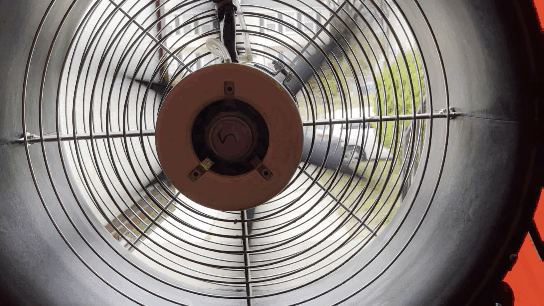
Shown: Air Leakage in Basement @ Top of Foundation Wall (rim joist) During Blower Door Test
-Back to Top-
3. Fireplace Flue & Recessed Lights - Sealing Up "Gateways" to the Outside
One easy way to find drafts is to look for the "gateways" to the outside.
For example, one out of every five customers that I do an energy audit for does not have the flue shut on their fireplace chimney which is a huge gateway to the outside.
Recessed lights are also gateways to the attic (outside) and it is a good practice to check the dampers on any exhaust fans you have venting to the outside. A mis-aligned, damaged or non-existent damper can be a real draft maker.
Sealing Solutions
- Covering and sealing can lights at the attic floor
- Improving household exhaust terminations
- Use a chimney "balloon" to seal faulty flue dampers
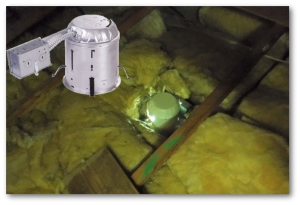
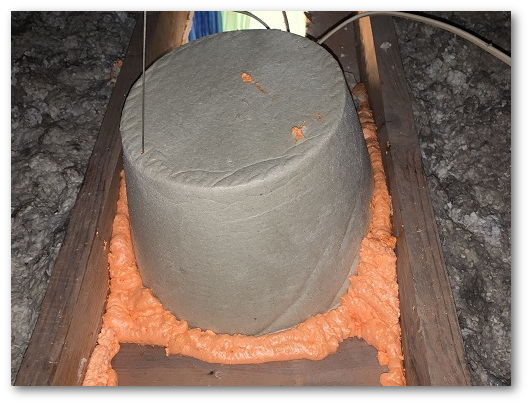
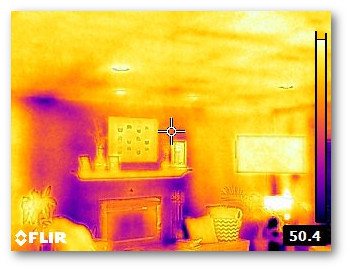
Watch How we Seal Big Holes in the Attic
Then We Measure How Much We Sealed the House
Here is Something to Chew On:
Your window contractor will not measure this for you.
-Back to Top-
4. Improperly Treated Crawl Space/ Basement
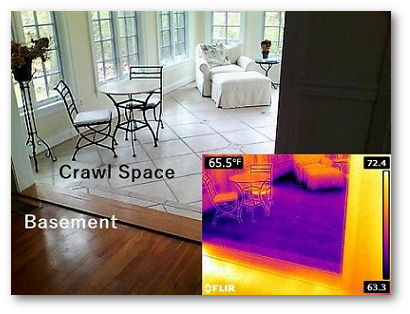
If the construction style of your home is on a crawl space that is open, then you might experience high drafts.
An open crawl space will allow unconditioned air into the the crawl space and unless there is a proper pressure boundary separating the crawl space from the room above, then drafts will surely occur.
Open crawl spaces traditionally have vents in the foundation wall. The theory is to allow fresh air into the space and keep it dry, but in actuality the complete opposite happens in summer. Crawl spaces become breeding grounds for insects, moisture and both want into your house! In winter it is a constant source of cold air into your home.
If you have a full basement it is very likely that the rim joist in any finished or unfinished area has not been properly air sealed and this will allow air infiltration in the basement area that will cause drafts through walls and floors into the living space above.
Check Out this Test I Did
I tested the house before any work, after air sealing, and then after the windows.
Can you guess which was more effective?
-Back to Top-
5. Improperly Installed or Misaligned Windows
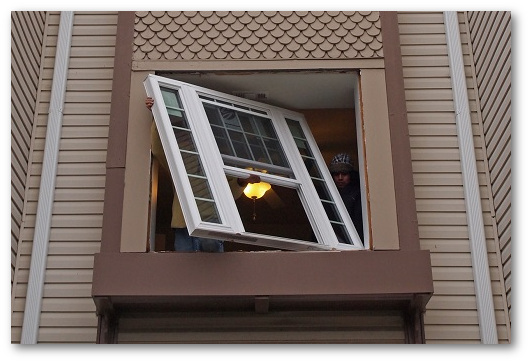
Another possibility for drafty new windows, however the least likely, is that the windows were installed improperly or worse yet, not caulked and sealed.
Even if this is the case, it would still be difficult to make a draft problem worse with new windows even if the windows are incorrectly installed due to pressure dynamics in a house.
It is important to note however, that basement windows and windows on the second floor could be susceptible to leakage if not properly installed and sealed due to higher pressure.
Make sure your windows are fully closed and locked!
Another common issue that homeowners with new replacement windows have problems with is making sure that top sash in double hung windows (most common type) are pushed all the way up in the u-shaped header.
When new window users are not accustomed to both sashes of the windows being operable, the thought that the upper sash dropping down does not come to mind and the notion that the windows are leaky is the typical conclusion. Operable windows have several parts that all work together for peak performance. If one thing is slightly off track, the rest of the system can suffer.
Watch: Window Installation Steps
Watch: Air Sealing Windows
-Back to Top-
Drafty Window Solutions: What will actually work?
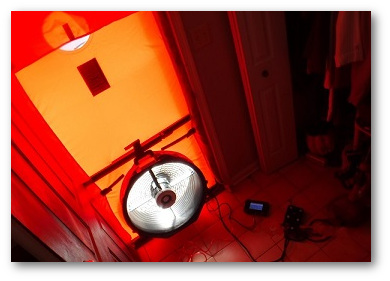
Get a Comprehensive Home Energy Audit
A great way to deal with the issue of drafty new windows is to have a comprehensive home energy audit performed.
An energy audit includes a blower door test so you can find the sources of your drafts.
A great energy auditor will guide you to better comfort with knowledge and diagnostic tools.
If you decide not to have an audit then you can sign up for this blog or read this article about the unobvious ways in which your home is inefficient.
-Back to Top-
________________
I would like to hear your comments about this article. Feel free to post something below...



















